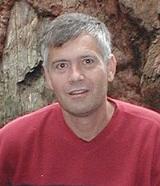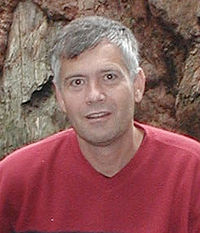
George van Driem
Encyclopedia

Background
George van Driem has conducted field research in the Himalayas since 1983. He was commissioned by the Royal Government of Bhutan to codify a grammar of the national language Dzongkha, design a phonological romanisation for the language known as Roman Dzongkha, and complete a survey of the language communitiesof the kingdom. He and native Dzongkha speaker Karma Tshering co-authored the authoritative textbook on Dzongkha. George van Driem has also written grammars of Limbu
Limbu
-Limbu people:*Limbu people a Tibeto-Mongoloid ethnic group in Asia, an indigenous ethnic group of Nepal.*Limbu language*Limbu script*Kirati nation.-Limbu History:*Limbuwan*History of Limbuwan*Limbuwan Gorkha War*Limbuwan-Gorkha Treaty of 1774...
and Dumi
Dumi
Dumi is a village in Achham District in the Seti Zone of western Nepal. At the time of the 1991 Nepal census it had a population of 1,517 and had 332 houses in the village....
, two Kiranti languages spoken in eastern Nepal, and the Bumthang
Bumthang
Bumthang may refer to:* Bumthang , officially Jakar* Bumthang District* Bumthang River* Bumthang Kingdom* Bumthang language* Bumthang Province* Bumthang Valley...
language of central Bhutan. He authored a two-volume ethnolinguistic handbook of the greater Himalayan region entitled Languages of the Himalayas. Under a programme named Languages and Genes of the Greater Himalayan Region, conducted in collaboration with the Government of Nepal and the Royal Government of Bhutan, he collected DNA from many indigenous peoples of the Himalayas.
Research
In Bern, George van Driem currently runs the research programme Strategische Zielsetzungen im Subkontinent (Strategic Objectives in the Subcontinent), which aims to analyse and describe endangered and poorly documented languages in South Asia. This programme of research is effectively a diversification of the Himalayan Languages Project, which he directed at Leiden University, where he held the chair of Descriptive Linguistics until 2009. He and his research team have documented over a dozen endangered languages of the greater Himalayan region, producing analytical grammars and lexica and recording morphologically analysed native texts.His interdisciplinary research in collaboration with geneticists has led to advances in the reconstruction of Asian ethnolinguistic prehistory. Based on linguistic palaeontology, ethnolinguistic phylogeography, rice genetics and the Holocene distribution of faunal species, he identified the ancient Hmong-Mien and Austroasiatics as the first domesticators of Asian rice and published a theory on the homelands and prehistoric dispersal of the Hmong-Mien, Austroasiatic and Trans-Himalayan linguistic phyla. His historical linguistic work on linguistic phylogeny has replaced the unsupported Sino-Tibetan hypothesis with the older, more agnostic Tibeto-Burman phylogenetic model, for which he proposed the neutral geographical name Trans-Himalayan in 2004. He developed the Darwinian theory of language known as Symbiosism
Symbiosism
Symbiosism is a Darwinian theory of language that recognises language to be an organism residing in the human brain. Language is a memetic life form. By the Leiden School definition, memes are meanings, i.e. isofunctional neuroanatomical constructs corresponding to signs in the sense of Ferdinand...
, and he is author of the philosophy of Symbiomism
Symbiomism
Symbiomism is the philosophy of George van Driem about mind and man’s place in nature that grew out of Symbiosism. Symbiosism is the linguistic theory that recognises language to be a memetic life form inhabiting the human brain. Human beings are unique symbiotic relationships in which the...
.

